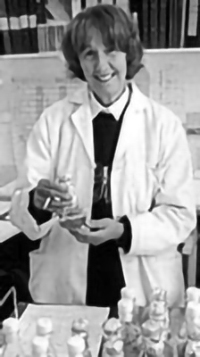
Shirley Jeffrey received a BSc from the University of Sydney in 1952 and an MSc in 1954. For her PhD, she went to King's College Hospital Medical School in London and worked on the effect of aspirin on carbohydrate metabolism. She returned to Sydney in 1951 to work with Dr George Humphrey at CSIRO Division of Fisheries and Oceanography. This was the beginning of her lifelong career in marine science. From 1962 to 1964, Jeffrey was at the University of California, Berkeley, as a research fellow funded by the Kaiser Foundation. In 1965 she was invited to join the maiden voyage of the Alpha Helix, the research vessel of the Scripps Institution of Oceanography at the University of California, which was coming to Australia to study the ecology of the Great Barrier Reef. Jeffrey was a principal research scientist at CSIRO's marine biochemistry unit between 1971 and 1977. From 1977 to 1981 she was a senior principal research scientist at CSIRO Division of Fisheries and Oceanography and then acting chief of CSIRO Division of Fisheries Research (1981–84). In 1991 she became a chief research scientist. From 1978 to 1995 Jeffrey was in charge of developing the CSIRO Collection of Living Microalgae (also known as the Algal Culture Collection). In 1996 UNESCO published Phytoplankton Pigments in Oceanography which Jeffrey co-edited.
Interviewed by Dr Trevor McDougall in 2000.
Funded by 100 Years of Australian Science (National Council for the Centenary of Federation).
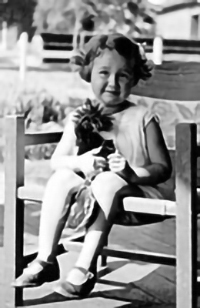
Dr Jeffrey, do you think your family background influenced your interests as a child?
My parents were English – my mother and father came from old English families – but they met in Mauritius, a small island off the coast of South Africa. After they married, they came via New Zealand to Australia, where they had their family of four children, three girls and a boy. (I am the second.) We were an 'ordinary' family, all very different from each other and interested in all sorts of different things. I am the only one who has ended up in science.
What led you to study science? Was it your school experience, perhaps?
My father was an executive in an American oil company. He was always being moved around Australia as he 'climbed the ladder', and so I went to 14 different schools. The one which had the most positive effect on me was the Methodist Ladies College in Melbourne, where I was for four years (1942-46). That wonderful school developed all aspects of the children, from the academic to music to sport, art, craft and business. At the age of about 15 I did a general science course there, with an absolutely marvellous teacher who inspired me with the wonder of the natural world and how it worked.
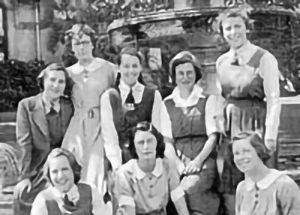
I became interested in general biology and the function of the cell and how the animal body worked. It was the functioning of the animal body that inspired me – and the character of Miss Connie Glass, who was our science teacher. At this time, too, I was inspired by reading a book on the life and work of Marie Curie, who worked in a lab with her husband. I thought in my romantic, young way how wonderful it would be to have such an experience myself.
The Sydney school where I did my last two years of schooling had no facilities for teaching science, however, and so I ended up going to university with maths, English and languages (French and German) majors but no science prerequisites at all.
At the University of Sydney without those prerequisite subjects, how did you remain in science? Did you have a particular role model there?
With a number of other girls I went to extra tutorials at the university in the months before we started first year science, but that year was very tough while we tried to catch up. Once we got through it and we were into the new subjects, life became much easier.
I did the first-year general subjects of maths, physics, chemistry and botany, but then in the biochemistry years it was Professor Jack Still who opened up for me the wonder of the functioning of individual cells in an animal or a plant. With the advent of electron microscopy, the internal architecture of cells was just beginning to be explored. To see the fine, minute structures was wonderful – it really inspired me.
So you did a first degree and a Master's degree at Sydney University?
Yes. After majoring in microbiology and biochemistry for the BSc in 1952, I was offered a chance to do a Master's (MSc) with Dr George Humphrey, in the Biochemistry Department. The topic of my thesis (completed in 1954), the metabolism of oyster sperm cells, was one aspect of a number of studies he was doing for the oyster industry in Sydney. Dr Humphrey was really my early mentor. He was marvellous in teaching me the fundamentals of experimental design and how to conduct experiments in the laboratory – I used to set out each day's experiments and tidy up at the end of the day. He taught me to think.
After your Master's degree you went to King's College, in London. How did that come about?
In those days it was the done thing for young women to go overseas when they had finished the first stage of their studies or they had earned enough money. So I went off with a friend to see the world, and while I was in London I had the opportunity to join a small research group at King's College Hospital Medical School, with the opportunity to do a PhD if the work turned out well. Although there had been a lot of applicants for the job, I was told later that it was my Australian accent that got me in, and the fact that I had done some rather 'sexy' things in my early Master's research – related to oysters, of course.
My study and thesis at King's College (completed in 1958) with Dr M J H Smith were in biochemical pharmacology, on the effect of aspirin on carbohydrate metabolism. In those days aspirin was used to treat diabetes but it had some hazardous side effects, and we were studying the bad side of aspirin treatment.
After your PhD, what led you back to Sydney, into a job at CSIRO at Cronulla?
I wanted to get back to Australia, but there weren't very many jobs on offer. It was Dr George Humphrey, who had moved from Sydney University to become Chief of the CSIRO Division of Fisheries and Oceanography, who offered me a job.
He had become interested in biological oceanography, a worldwide trend in marine science at the time. We were looking for a simple chemical method for measuring the biomass of microalgae (the floating plants of the ocean) in seawater. The approach suggested was to harvest the microalgae, extract the pigments – the green chlorophyll – and measure, by a chemical spectrophotometric technique, the absorption of the chlorophyll at different wavelengths. This method could be carried out quite quickly and you could do masses of samples, provided you knew quantitatively the characteristics of the pigments in the marine algae. To find out those characteristics, my task was to develop a micro-method for separating all the pigments (up to one hundred) in the microalgae – of which there are tens of thousands of species, though conveniently grouped in 14 algal classes – and to purify the major marine chlorophylls found in many of the groups.
I came to this job (in 1958) from biochemistry and pharmacology, and when I told Dr Humphrey I didn't know anything about algae he said, 'It doesn't matter. You've been trained how to think, and how to carry out research, and you can always look things up in a book if you need to.' I have never really studied this field formally, and I have been learning ever since those early days. I'm still learning.
You have had some very beneficial trips. The first, about three years after arriving in Cronulla, was on a sabbatical to Berkeley, in the US, funded by the Kaiser Foundation. What resulted from that?
I worked in a biochemistry laboratory for 2 years (1963-64), which was one of those at the forefront in photosynthesis (with Dr Mary Belle Allen). They wanted me to prepare some of the new marine chlorophylls, but I also preferred to get wider experience. Their algal culture collection interested me very much and I also learnt new photosynthetic techniques, as well as meeting many of the post-docs from the other photosynthesis labs on the Berkeley campus. One, a young Englishman, gave me some polyethylene powder he had been using for separating terrestrial chlorophylls, and when I came back to Australia I was able to use that to advantage in working with the marine chlorophylls. That unexpected side benefit was wonderful, and allowed the discovery of two new chlorophyll c pigments, separated and purified for the first time on the polyethylene powder from Berkeley.
You went on the maiden voyage of the research vessel Alpha Helix. What was the importance of that cruise?
It happened in 1965 when I returned to Australia and some of my work had been published. I had no indication that the Alpha Helix – the new research vessel of the Scripps Institution of Oceanography at the University of California – was coming to study the ecology of the Great Barrier Reef until I received a phone call from the chief scientist, Professor Francis Haxo. He had arrived in Sydney and was staying in Kings Cross, and he invited me to breakfast. This might seem a rather wild assignation – and it was! – but he asked me to join the voyage, leaving in a couple of days' time, to look at the pigments in the microalgae that are symbiotic in tropical reef animals. That was a most marvellous adventure, which lasted for two and a half months.
On board there were some very famous people in science. Professor Haxo is an expert in algal pigments, and he had invited me because he thought that as cruise leader he would be too busy to do as much work as he wanted. Then there was Professor Kazuo Shibata, who amongst his other marvellous achievements designed the Shimadzu spectrophotometer. He brought the first prototype in a huge box which was lifted by crane onto the ship and finally installed – the first recording spectrophotometer of this type. He used to go round in his kimono and little clogs, and we had a great rapport. The third person was Professor Per Halldahl, a Norwegian photo-physiologist. His wonderful machinery (which he brought in a suitcase) was for measuring the activity of algal populations symbiotic within corals, clams and other animals on the reef, and the effect of underwater light on them.
Would you like to say a few words about your 1973 sabbatical to the Scripps Institution of Oceanography, where you got to know your future husband?
On the Alpha Helix cruise, one of my tasks had been to find out what kind of algae inhabited the coral and clam tissues in the very nutrient-deplete environment. I did that by looking at the pigment characteristics, and as a result of those publications my name became known to scientists at Scripps in California and Professor Andrew Benson invited me to come for a sabbatical to his laboratory. He had been one of the key doctoral fellows in Professor Calvin's lab at Berkeley in the 1940s, where the pathway of carbon in photosynthesis was first unravelled – a Nobel prize-winning achievement for Professor Calvin.
Sharing a laboratory with Professor Benson and his many students and post-docs was an amazing experience – a little bit too much for me, in a way. We published a very interesting paper together with one of his French post-docs, now Professor Roland Douce, on the pigments in the yellow envelope of the chloroplast. Professor Francis Haxo, the carotenoid expert, also invited me to share his lab. That was a very exciting and productive time. Certainly to be at Scripps, where there were so many wonderful lectures for the graduate students and the post-docs, was a stimulating experience.
And at the same time at Scripps I got to know an Australian scientist, Dr Andy Heron, a zooplankton population biologist, who was also on sabbatical. It was the beginning of a life-long adventure.
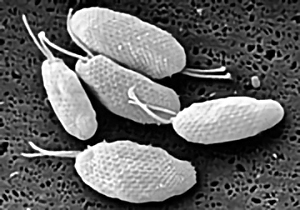
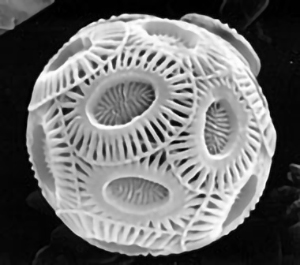
For several years in the 1970s, your group – while remaining part of the CSIRO – was moved from Cronulla to the University of Sydney. Would you tell us about that?
The CSIRO Executive, reviewing the Division in the 1970s, decided that Dr Humphrey should set up a new Marine Biochemistry Unit. We eventually settled in the Botany Department of Sydney University, where I met Dr Maret Vesk, an expert electron microscopist who was looking for a new field to study. Although our Algal Culture Collection was still only small, about 30 strains, those cultures of microalgae and their unique cell ultrastructure inspired her, and with her excellent techniques we were able to do a lot of collaborative new work with microalgae. That allowed us to expand into the field of microalgal taxonomy, where you need to have ultrastructural details of the cell surface and internal structures to establish species concepts.
And so that was really the beginning of the electron microscopy work on algae. What caused your group to move back to Cronulla, in 1977?
A new Chief, Dr K Radway Allen (a fisheries scientist) had been appointed in the 1970s to revitalise the Division at Cronulla. There was a gap in the food chain studies because all the algae work had been moved to Sydney University, so we were reviewed again by CSIRO and they decided to send me back with the Culture Collection, to Cronulla in 1977-78. To establish microalgae work again in the Division, Dr Radway Allen gave me a lot of resources, particularly money, to set up a good algal culture facility. Instead of the usual air-conditioned room with a few lights, a few shelves and no back-up, we designed new facilities to have three walk-in algae growth rooms, six cabinets all temperature-controlled with duplicate compressors, and back-up machinery in case anything went wrong. So the facility was much safer, and being able to grow algae under any temperature, from 5ºC for polar organisms to 30ºC for tropical organisms, allowed the scope of our work to take off. That was a wonderful period – and a Dutch postdoctoral fellow, Dr Gustaaf Hallegraeff, who came just for eight months to learn techniques, is still here, now Professor of Plant Science in the University of Tasmania, over 20 years later!
After four years of rapid growth of the Algal Culture Collection, and of work on phytoplankton ecology and electron microscopy, you received a phone call from the Executive of CSIRO. What was that about, Shirley?
Early one morning (in late 1981), the phone rang, and Dr Ken Ferguson, our Institute Director, asked me, 'Would you become Acting Chief of the Division of Fisheries for six months?' My response was, 'How can I, when I know nothing about fish?' But I did say yes.
The background to that phone call was that the Division of Fisheries and Oceanography had been split into two divisions. Dr Angus McEwan headed up the new Division of Oceanography, but the inaugural Acting Chief of the Division of Fisheries, Dr Brian Stacey, after 12 months in the job, was recalled to his own Division and CSIRO needed time to readvertise for his replacement.
That was a time of great expansion for CSIRO in marine science, including a new research vessel, the Franklin, and my six months as Acting Chief became three tumultuous years while the Division moved from Sydney to Hobart. But first I went round and sat with all the staff of Fisheries one by one – senior and junior – to let them tell me about their work. Dr Garth Murphy was the head of the fisheries section at that time. I think some of the senior people were a bit aghast at what was happening, but they gave me very generous, unstinting help and support. Not only did I have to learn about fisheries, but I wasn't trained as a manager either. I took myself off to a time management course immediately and I have followed those principles ever since. We had a very good administrative support team, with Mr Geoff McDonald as Divisional Secretary, the key person making sure I didn't do anything too wrong.
The business of transferring the Division of Fisheries from Cronulla in NSW to Hobart in Tasmania resulted in 60 redundancies and was very traumatic for the staff. Partly to give people something else to think about, I decided to engage the Division in a big, urgently needed multidisciplinary project off the North West Shelf. Basically, we were looking at the demersal fisheries up there, which were being ruined by the Taiwanese pair-trawlers. Dr Keith Sainsbury initiated the idea, but it was Dr Peter Young who organised the logistics of the whole program.
And you had to interact with people in Canberra as well.
Yes, with Dr Robert Bain, who was head of the Commonwealth Department of Primary Industry-Fisheries Division. There was also continual dialogue between CSIRO, who were supposedly doing the research required by the Commonwealth Department of Primary Industry, and various State Fisheries Departments round the country. Our very interesting 'sparring' relationships worked very well because we respected one another.
Finding a new Chief of the Division while I was Acting Chief took a long time, probably for a number of reasons. There were several rounds of advertisements. The first round brought some very good applicants, but some of them perhaps applied for the job because of other agendas. Also, it was going to take three years before the new laboratories were built in Hobart and the Fisheries Division could move there, and no person in their right mind would want to take on the leadership of an organisation in the throes of such a dramatic change.
No-one except you?
Well, I was there anyway! And they said it was only for six months.
Very few other scientists have managed to achieve a transition from being a full-time administrator back to the bench to be an active scientist again. How did you manage that transition?
When our new Chief arrived in August 1984 (Dr Roy Harden Jones from the Fisheries Laboratory Lowestoft, UK) there was no question about whether I would go back to the bench, since it was what I wanted to do – but I did find the first year extremely difficult. We had four container loads of equipment and glassware to be assembled and washed; the laboratories had to be made clean for our live algal cultures to flourish; the biochemistry lab, the electron microscopy lab, everything, had to be set up. That process took about a year to get running. And it was extremely difficult psychologically to come from having the top job, where you make all the decisions, to being at the bench, unpacking, cleaning. It was very good for my psyche to have to do that, because it brought me back to earth!
Let's look now at your scientific research achievements. To turn the clock back to the early days in Cronulla, when as a fresh research scientist you were given the task of purifying chlorophyll: just what was the task and how did you go about it?
There had been some attempts to purify the marine chlorophyll, known as chlorophyll c. Chlorophylls a and b are found in green leaves and had been extensively studied by the early pioneers, but the c compound was only found in marine forms and needed urgent study for helping to assess algal biomass in the sea. In order to do that you had to have the pure compound, but getting enough material from microalgae would be difficult so I decided to use seaweeds growing off the laboratory at Cronulla. I used to go down and collect a few fronds of Sargassum, extract it in the lab and separate the various fractions of pigments by chromatography. It was a long, long development, because the problem with the chlorophyll c was getting rid of all the polar lipids that were in the fraction, and I had to use the technology of the day (not very advanced) for lipid fractionation. After many months of struggle I thought my preparations were very close to crystallisation – by now my tests for detecting the presence or absence of lipid were showing me that my purified extracts should be pretty clean.
I set the flasks in a special configuration in the freezer and used the appropriate solvents for crystallisation to happen, achieving a lovely dark emerald green–red fluorescent solution. But next morning a desperate sight awaited me: the green had turned to a yellowish colour and there was a lot of red material at the bottom of the flask. I was devastated. I thought all the chlorophyll must have broken down, because chlorophylls are very sensitive compounds, highly reactive, and the littlest thing such as traces of oxygen or acid can destroy them. I thought the washing-up assistant had not cleaned the flasks properly, leaving on them traces of the chromic acid that we used for cleaning the glassware. So I offered to do all my washing up for the next couple of months, doing the rinsing and everything, and set off down the hill again for my next batch of seaweed.
I went through the same purification processes in the ensuing weeks and got to the same stage, only to find the emerald green solutions turned yellowish again, with a red sediment on the bottom. But then, when I examined the red material under the microscope to see what it was, there was the answer: the most beautiful green–red fluorescent crystals I had ever seen! We had done the job but I hadn't recognised it the first time round.
So they had gone down the sink the first time?
Yes. I was expecting green or black crystals, not red. Chlorophyll is a compound for absorbing light and transferring the light energy on to other compounds. I hadn't realised that when it was pure it would also emit absorbed light (at another wavelength). It was showing its potential characteristic as a highly reactive light-absorbing compound, but of course I hadn't thought of that. Nature had to show it to me. That was a great moment.
The Scientific Committee on Oceanic Research (SCOR) Working Group on the Determination of Photosynthetic Pigments in Seawater was an important catalyst in making these results available to the general scientific community. Would you tell us about that working group?
It's a pretty long story, but in the early 1960s Dr Humphrey was a member of a SCOR working group on Photosynthetic Pigments which was to hold a meeting at UNESCO somewhere near the Eiffel Tower, in Paris in 1964. I had just crystallised the chlorophyll c, so as a little prize I was taken along to meet the great people in pigment work who were on this committee.
We were trying to improve the chemical methods (spectrophotometric equations) for measuring chlorophylls in seawater. I had the first data on pure chlorophyll c and so at this meeting we made another set of equations, but then later on, using the powder given to me by the English post-doc at Berkeley, we found that chlorophyll c from seaweeds was really made up of two very closely related compounds. Subsequently we found a third, and now, in the year 2000, nine chlorophyll c compounds have been described, some by Dr Garrido and Dr Zapata, Spanish colleagues. It has been an ever-expanding field – but why there are so many closely-related chlorophyll c pigments, we don't yet know.
Back in about 1985–86 there had been a lot of concern about global warming/greenhouse effects, and a new oceanographic international program called JGOFS – the Joint Global Ocean Flux Study – was set up to look at all kinds of oceanographic parameters in physical, chemical and biological oceanography. Scientists in the UK who were concerned about the chlorophyll methods wanted to have a working group to make state-of-the-art methodology available to all the research teams in the world who would be working on this program. So working group 78 was established by the Scientific Committee for Oceanographic Research (SCOR) in 1986.
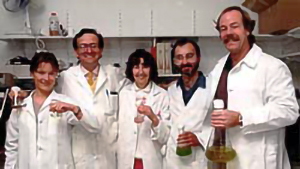
The chairman of this group was Dr Fauzi Mantoura, from the Plymouth Marine Laboratory. I went to the initial meeting in Plymouth and then gradually we decided that we needed to have some workshops on calibrating chlorophylls and carotenoids and field samples. Half a dozen world experts, including my colleague Dr Simon Wright of the Australian Antarctic Division, came together in Hobart for two of those workshops – one on chlorophylls and one on carotenoids – where we made the pigments and tested them with all our different methods and instruments – eg, spectrophotometers, fluorometers and HPLC (high performance liquid chromatographs). The third workshop, which I didn't attend, was in Plymouth. As a result of all that work we have now published a new volume on photosynthetic pigments in oceanography (published by UNESCO in 1997), summarising the results of all our workshops and making recommendations for the best methods to use in different situations. It is a bit like a handbook, but it is rooted in the literature and is also a repository of all the information you might possibly need at the present time. All this is to help more accurate assessment of microalgal biomass in the sea from ships or from satellites by remote-sensing.
Over the past 15 years your work has been very beneficial to the aquaculture industry. Perhaps you could say how that came about.
Before we came to Hobart, our Culture Collection was used very actively by many institutions in Australia for research and teaching. But then, when we transferred to Hobart in 1984 we immediately were asked to assist the Tasmanian aquaculture industry. Tasmania has a flourishing aquaculture industry – fish farming, oysters, mussels, salmon and so on – which use microalgae in mass cultures for feeding larval fish and shellfish. The principles of microalgal mass culture were not fully understood at the time, and so a colleague at the University, Dr Christian Garland (a microbiologist who was working with the aquaculture industry) came and asked me for a number of favours. Could he use our facilities? Of course! Could we hold some of the strains that were important for the aquaculture industry? We were happy to do that. And then, would I come and visit some of the aquaculture farms in Tasmania that he had access to? I was delighted to do that, and my eyes were opened with absolute amazement at the huge tanks and vats of microalgae – though only a few species – being grown in all these fish farming situations.
In those days, however, some algal cultures would 'crash' unaccountably overnight – a devastating financial disaster for farmers who had millions of, say, oyster larvae needing their daily food. So one thing we were looking at was the health of the cultures: the procedures used for maintaining sterility, freedom from bacteria, and the correct light, nutrients, aeration and temperatures for growing the particular microalgae. As a result, we put in proposals to the Fishing Industry Research and Development Council (FIRDC) for money to help the aquaculture industry by looking at the nutritional qualities of microalgae grown under different conditions, and searching for new Australian strains suitable for Australian conditions.
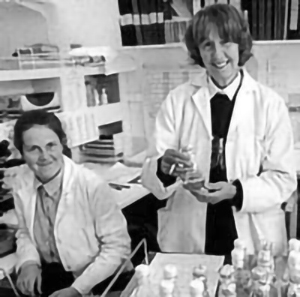
Consequently we recruited our postdoctoral fellow, Dr Malcolm Brown, who is now a permanent member of CSIRO, and our microalgal biologist, Ms Jeannie-Marie Leroi, who has been in charge of the day-to-day running of the Collection for some years now, doing an excellent job in culturing the algae. She has just finished her MSc at the University of Tasmania. We were able to collaborate with the chemists in our Division – especially Dr John Volkman, a lipid chemist – to do very rigorous nutritional work on our microalgae strains and to recommend to the industry better, more useful strains, as well as Australian isolates.
That has been a great use of our Culture Collection: for the first time it could be used not only for research but in an industry that was very important to Tasmania. We were able to get the early stages of fish farming husbandry onto a good footing.
The Algal Culture Collection has been used also for the study of toxic dinoflagellate blooms. How did that work begin?
In Hobart in 1984, our new Chief no longer gave us responsibility for offshore work, so we were looking around for new things to do. Dr Gustaaf Hallegraeff had by then become a permanent part of our group as our ecologist/taxonomist, and one day he took a plankton net down to the CSIRO wharf to see what he could find of interest. Within half an hour he came back saying, 'The river's full of toxic algae.' (Having held an international algae workshop in Cronulla just before we moved to Hobart, we could easily recognise the strains.) So Dr Hallegraeff received FIRDC funds to study how and why these toxic algae came to be there in fish farming areas. They seemed to have been a recent introduction, and Gustaaf's careful work and lateral thinking led him to think that some of the overseas ships (for instance the Japanese woodchip ships that came to Triabunna and Hobart) might have emptied out their ballast water, complete with toxic algae which were normally present in the highly polluted Japanese waters at the ports of origin.
We now have a lot of those strains in our Culture Collection. Dr Sue Blackburn, in our laboratory, has succeeded in working out the life histories of these species. We have been able, by genetic mapping, to find out which of the strains we have here are compatible with which overseas strains, and there certainly seems to be a linkage between the Tasmanian and the Japanese strains. It is highly likely that they were a recent introduction.
The way to cope now, since we'll never get rid of these microalgae, is to know their life cycles, to have very rigorous monitoring programs and to have the oyster farmers very clued up about it all. The local State Fisheries now do a lot of monitoring, both of the algae and of the toxins they can put into the food chain.
We haven't yet talked about the effect of ultraviolet radiation on algal growth.
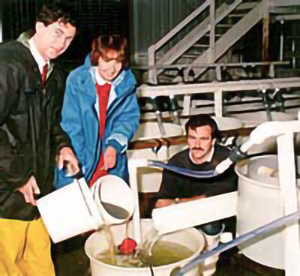
This is a recent study. Because of the depletion of the stratospheric ozone layer by chlorinated compounds (which are used to make plastics, for example) and the subsequent increase in UV radiation reaching the Earth's surface, there was quite a big concern about 10 years ago that we should look at the ecological effects of ultraviolet radiation on marine and terrestrial ecosystems. With our Algal Culture Collection, which now has 700 strains in it, we received funding from the Australian Research Council (ARC) to look at the distribution of sunscreen – UV protective – pigments in microalgae. We have just published a paper on our search for such compounds, which are found in only a few groups of algae: dinoflagellates, cryptomonads and other algae which form surface blooms that normally receive ultraviolet radiation. Algae can make water-soluble UV-absorbent compounds which provide an effective screen to the delicate, easily damaged parts of the cell such as the nucleus or the photosynthetic apparatus. Not all algal groups are protected, so if the ultraviolet levels increase, there could be an ecological change in species composition. Some algal groups might take over from others which are less protected. And all the mechanisms of how this happens, we would like to look into further.
During your career, Shirley, do you think you have experienced any discrimination on the basis of gender?
I don't really think so. I've had a lot of support. Dr George Humphrey, my original mentor, was extremely supportive, and I have had great encouragement from people here and overseas. When I started publishing my work as a young scientist it was the convention for women to use their full first names so that their sex would be clear. I thought, 'Why should sex come into it?' so I always used my initials. And it did take people a long time before they found out that I was not a man!
You have been awarded a number of honours, including the inaugural Jubilee Award of the Australian Marine Science Association in 1988, election as a Fellow of the Australian Academy of Science in 1991, becoming a Member of the Order of Australia in 1993, and just this year election as a Foreign Associate of the American National Academy of Sciences, plus several medals. What have these honours meant to you?
Well, when I first heard about each one in turn I was absolutely amazed, astonished and overwhelmed by the recognition of such a very little-known field. Certain of my male colleagues obviously had something to do with putting my name forward. The recent election as a foreign associate to the US Academy was totally unexpected, as was the US Academy's Gilbert Morgan Smith Medal for research in algae, and I still wonder about these things, but it is wonderful to find that our field of microalgae is now coming of age. I accept these awards on behalf of all my colleagues who share this exciting work, and I feel privileged that CSIRO gave me the opportunity to work in this area.
Would you care to comment on the importance of the basic, as opposed to the more applied, research in your career?
When I came into our particular field more than 30 years ago, very little was known about the biochemistry and physiology of microalgae, or even the taxonomy of species in the Australian region. Without our wonderful period in CSIRO, which supported blue-water research – unfettered exploration of a scientific problem – we wouldn't have been able to build up the knowledge that we needed when, in later years, we came to help solve applied problems. The 20 years or so of basic research into the life cycles, biochemistry, physiology, cell biology of microalgae have been absolutely essential in enabling us to go further.
Would you like to say a few words about your interests outside of scientific research?
Recently I have had a bit more time to pick up things that I used to do long ago. I play tennis regularly and love going bushwalking, and I do some music. I have joined a few of the activities around Hobart: I am a member of Jane Franklin Hall – a college of the University of Tasmania – where I am a Fellow and have been on the Council, and I have been an office-bearer of the Royal Society of Tasmania, which has been interested to bring to the public, in symposia, topics of general interest. I have also done some teaching at the University of Tasmania, but I suppose that's not really what you were asking me!
In closing, Shirley, do you have some words of advice for younger scientists, perhaps just starting out in their career?
I think sometimes young people get discouraged by the current climate of no money, no jobs, and feel there may be no future. But I really think that if people are fascinated by science, and if they love it and are good at it, there's no question they can succeed. I would say, 'Go for it.'
© 2025 Australian Academy of Science